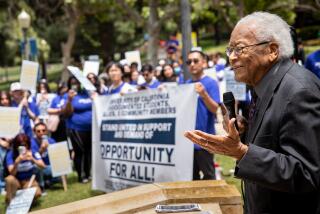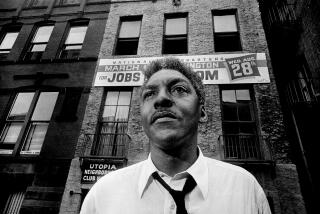Peace plans
- Share via
IMAGINE, Mark Kurlansky urges us in his new book, how different the world would be if nonviolence prevailed. “Violence does not resolve,” he writes in his book’s 16th lesson. “It always leads to more violence.”
Kurlansky’s exploration of the nonviolence movement ranges across history, and his advocacy of this philosophy is particularly compelling when he turns to current American battles in Afghanistan and Iraq, and to recurring conflicts between Israel and its neighbors.
To the politicians and pundits whose philosophy reflects the one-liner “Give war a chance,” Kurlansky promotes not pacifism, mind you, but a strategy for revolutionary change. Relieving rather than inflicting suffering and refusing to kill, the methods of nonviolence range from argumentation and negotiation to protest and resistance that utilize boycotts, sit-ins and strikes.
Practicing nonviolence has succeeded where violence never has, and Kurlansky’s book includes many instances of its decisive impact on historical outcomes: the end of South African apartheid, the toppling of the Berlin Wall, the downfall of Soviet Communism and the success of the American civil rights movement. Neither history nor Kurlansky’s interpretation of it, however, makes the case for nonviolence more than halfway: Events are more complicated than he admits, and his sweeping generalizations sometimes seem less than trustworthy.
Yet what is compelling here is the way that Kurlansky draws on humanity’s most fundamental ethical traditions to emphasize the preciousness of human life. At their best, the world’s religions resist violence and war, whose methods and alleged virtues never deserve the highest moral rank. Kurlansky balances the picture by underscoring that religion has often been used to support warfare. That alliance is especially regrettable because violence and war promise peace, goodness and joy that they can’t provide.
Throughout history, there have been many attempts to make war alluring. Kurlansky ably deconstructs these calls, which often have resounded with the words “just” and “holy” to make them reasonable. Two Christian leaders in particular, St. Augustine and Pope Urban II, are addressed early in the book, in the chapter “The Killer Peace Movement.” St. Augustine supported the idea of a just war. If the cause is good, right and urgent, and if the methods used are reasonably proportioned to the threat, then war -- especially in self-defense -- is legitimate and even necessary. When Pope Urban II launched crusades against Muslims in the 11th centuries, he emphasized that war could fulfill God’s will and thus be holy as well as just.
Kurlansky shows that versions of such sanctification of war remain captivating and widespread. Such identification conveniently separates those who are right and good from those who are not. Enemies are then demonized and set up for the kill. What cause pursued by war, Kurlansky wonders, has not been labeled just and holy? That query pushes readers even deeper into the issue when it is augmented by his arguable but plausible claim that wars typically defend the interests of the wealthy, powerful and privileged while being fought by the poor and disadvantaged and increasingly at the expense of civilians.
Interestingly, Kurlansky in his book’s subtitle calls nonviolence “a dangerous idea.” Promoting peace can be dangerous? He is on absolutely firm ground about that. It is not accidental that philosophies of nonviolence have been disparaged as unrealistic and contrary to human nature. Nor is it coincidental that practitioners of nonviolence have often been persecuted, beaten and killed, if only to provoke them to acts of retaliatory violence that would undermine the credibility of nonviolence. “Practitioners of nonviolence,” says Kurlansky’s third lesson, “are seen as enemies of the state.” The possibility of a nonviolent world is dangerous to every form of power that depends on the threat of war. Lip service given to peace notwithstanding, the prospect of human affairs no longer governed by the threat of violence must be marginalized by the powers that be, lest the meek inherit the Earth.
“Nonviolence’s” primary weaknesses are embedded in its strengths. Although Kurlansky draws on essential ethical premises, history shows, more than he admits, that those teachings are repeatedly subverted and overridden. History does little to suggest that humankind’s best ethical impulses hold sway, although their critical corrective function is lost at our peril.
The book is directed at a general audience, but even as “history lite,” what he presents as history is by no means altogether right. It is too simplistic, for example, to claim that nonviolence ended South African apartheid, brought down the Berlin Wall and Soviet Communism, and made the American civil rights movement successful. No doubt nonviolence played a key part in those situations, but it was only one element in complex states of affairs.
Kurlansky’s quick survey of the Holocaust is especially misleading. “More Jews,” he contends, “were saved by nonviolence than by violence.” He adds, “Contrary to popular postwar claims, the Holocaust was not stopped by the war. In fact, it was started by it.” Kurlansky’s revisionism continues by claiming that if the Allies “had wanted to save the Jews the best chance would have been not going to war.” No reliable Holocaust scholar would make such claims, at least not without nuancing them more carefully than Kurlansky does. When he plays fast and loose with history, Kurlansky harms the cause of nonviolence more than serving it.
And although Kurlansky argues persuasively that violence and warfare cannot solve humanity’s most crucial problems, his 25 lessons do not inspire confidence that nonviolence can prevail. “People motivated by fear do not act well,” his 18th lesson affirms. “Violence is a virus that infects and takes over,” says the 23rd. Kurlansky’s 17th lesson may be correct in asserting that “warfare produces peace activists,” but with war unceasing, their numbers do not match what his reasoning suggests they ought to be. In our world, where fear is rife, where violence and power intertwine, where war goes on and on, Kurlansky’s hopes for nonviolence are hoist by their own petard.
The book’s 25th and final lesson says that “the hard work of beginning a movement to end war has already begun.” Arguably Kurlansky’s book contains enough examples to justify that claim, but beginnings should not be expected to carry more weight than they can bear. Like this book, the beginnings of a movement sometimes promise more than they deliver. *
More to Read
Sign up for our Book Club newsletter
Get the latest news, events and more from the Los Angeles Times Book Club, and help us get L.A. reading and talking.
You may occasionally receive promotional content from the Los Angeles Times.










